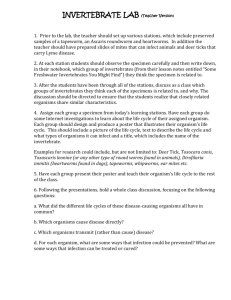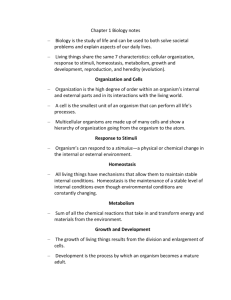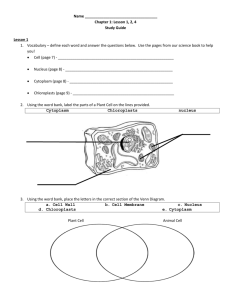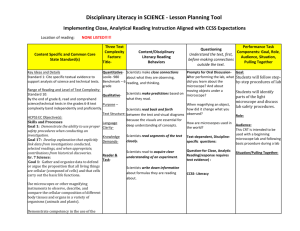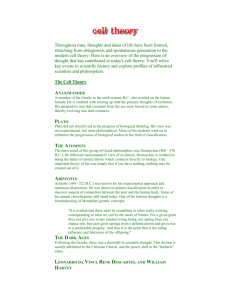How is life on
advertisement
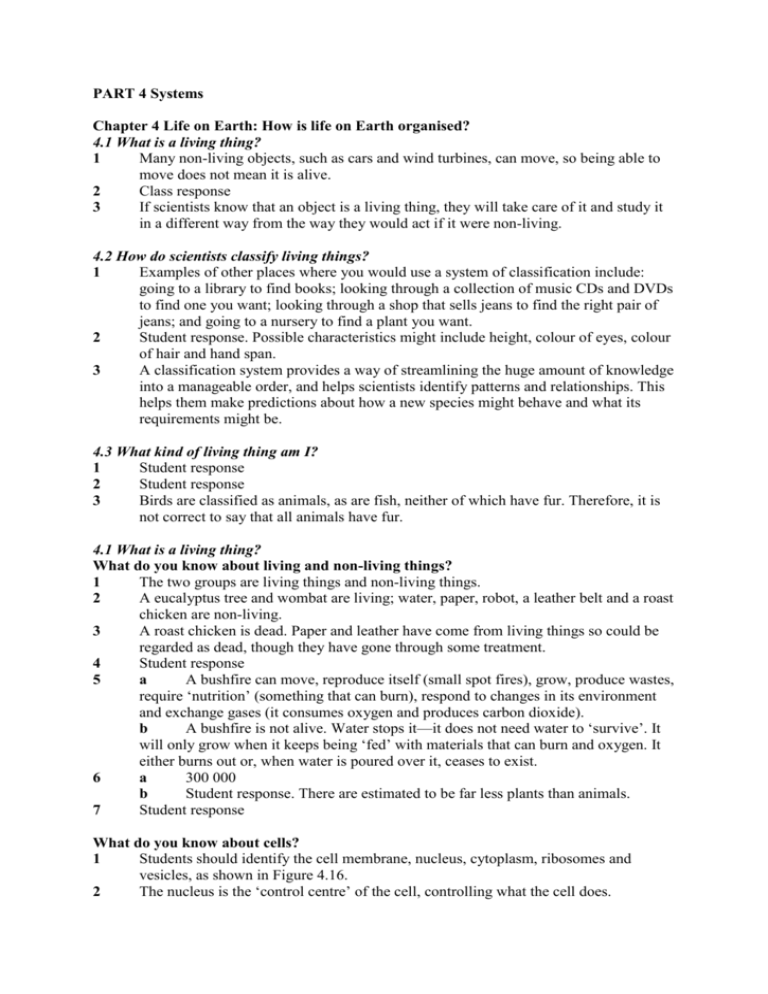
PART 4 Systems Chapter 4 Life on Earth: How is life on Earth organised? 4.1 What is a living thing? 1 Many non-living objects, such as cars and wind turbines, can move, so being able to move does not mean it is alive. 2 Class response 3 If scientists know that an object is a living thing, they will take care of it and study it in a different way from the way they would act if it were non-living. 4.2 How do scientists classify living things? 1 Examples of other places where you would use a system of classification include: going to a library to find books; looking through a collection of music CDs and DVDs to find one you want; looking through a shop that sells jeans to find the right pair of jeans; and going to a nursery to find a plant you want. 2 Student response. Possible characteristics might include height, colour of eyes, colour of hair and hand span. 3 A classification system provides a way of streamlining the huge amount of knowledge into a manageable order, and helps scientists identify patterns and relationships. This helps them make predictions about how a new species might behave and what its requirements might be. 4.3 What kind of living thing am I? 1 Student response 2 Student response 3 Birds are classified as animals, as are fish, neither of which have fur. Therefore, it is not correct to say that all animals have fur. 4.1 What is a living thing? What do you know about living and non-living things? 1 The two groups are living things and non-living things. 2 A eucalyptus tree and wombat are living; water, paper, robot, a leather belt and a roast chicken are non-living. 3 A roast chicken is dead. Paper and leather have come from living things so could be regarded as dead, though they have gone through some treatment. 4 Student response 5 a A bushfire can move, reproduce itself (small spot fires), grow, produce wastes, require ‘nutrition’ (something that can burn), respond to changes in its environment and exchange gases (it consumes oxygen and produces carbon dioxide). b A bushfire is not alive. Water stops it—it does not need water to ‘survive’. It will only grow when it keeps being ‘fed’ with materials that can burn and oxygen. It either burns out or, when water is poured over it, ceases to exist. 6 a 300 000 b Student response. There are estimated to be far less plants than animals. 7 Student response What do you know about cells? 1 Students should identify the cell membrane, nucleus, cytoplasm, ribosomes and vesicles, as shown in Figure 4.16. 2 The nucleus is the ‘control centre’ of the cell, controlling what the cell does. 3 4 5 6 7 The cell membrane keeps the cell together and controls what enters and leaves the cell. A bacterium is made up of one cell. a Multicellular means made up from more than one cell. b Answers should include any animals or plants. The invention of the microscope enabled scientists to see what makes up living things. This knowledge has helped doctors understand the causes of diseases, how to prevent diseases and how to cure them. It also has opened our eyes to the existence of far more living organisms than were first realised. Student model What do you know about microscopes and living things? 1 Class response 2 Response depends on the microscopes used by the student 3 You look from the side when you adjust the coarse focus knob to ensure that the objective lens is close to, but does not touch, the slide. 4 A wet mount is a microscope slide in which a couple of drops of water have been added to a thin slice of a specimen so that it sticks to the slide. This is then covered with a cover slip. 5 It is important to label and date your specimen drawings because you need a proper scientific record of drawings taken so that: the results may be compared with other specimens; changes can be seen over time; and results can be confirmed by other scientists. 6 Very thin specimens are necessary with a light microscope. If the specimen is too thick, light will not be able to pass through it and it will not be able to be viewed. 7 Microbiology is the study of cells and organisms that are so small that they can only be seen under a microscope. 8 The missing values are, in order: ×20, ×15, ×500, ×15, ×500. 9 Student response 10 The Venn diagram will have two circles—compound light microscope and stereomicroscope. The region in common in the Venn diagram might contain words like: magnifies specimens, coarse and fine focus knob, stage for specimen. The region for the compound light microscope only might contain words like: specimen thinly sliced, specimen must be dead, greater magnification possible, one or two eyepieces, two-dimensional image, image upside down and back to front. The region for the stereomicroscope only might contain words like: larger specimen, specimen can be alive, two eyepieces, three-dimensional image, image right way round. Big ideas 1 Characteristics of livings things: moves by itself, reproduces itself, grows as it gets older, responds to stimuli, produces wastes, requires nutrition, exchanges gas with its environment, requires water. 2 An organism is a living thing. 3 a coarse focus knob b fine focus knob c stage d base e eyepiece lens f objective lenses g light 4 5 6 7 8 9 10 An example of plants moving by themselves is when sunflowers twist around to face the Sun. The outside boundary is the cell wall, the large lime green part is a vacuole, the small darker green part is the cell nucleus, and the remainder is the cytoplasm. Chloroplasts are not very evident in this drawing. a i The nucleus is the ‘control centre’ of the cell, controlling what the cell does. ii A chloroplast uses light energy to enable it to produce the glucose needed by the plant for energy. iii A vacuole is a storage area for water and other substances. b Both animal and plant cells contain a nucleus and vacuoles but only plant cells contain chloroplasts. Safety rules for carrying a microscope: Always carry the microscope with one hand around the main part and the other hand under the base. Microscopes are very expensive and fragile and this will help prevent them being dropped. Always adjust the coarse focus knob from the side so you can check that it does not touch the microscope slide, otherwise the slide and lens may be damaged. It is important that scientists around the world use a common system to group all living things on Earth so they can then share information readily and efficiently. This enables them to identify patterns and relationships, and to make predictions, and saves a lot of valuable time and expense. To determine if an unknown organism is living or non-living, scientists could observe to see if it moves by itself, and test it with various stimuli, such as light and touch, to see how it responds. If it does not move or respond to stimuli, it is likely that it is a non-living object or a dead organism. If an animal had rigid cell walls, it is likely to be much stiffer and possibly may not be able to move from place to place. If it had chloroplasts, it is likely to look green. As roots are not mentioned, it would still need to obtain other nutrients by eating. 11 Currently living Teacher Your pet Daffodil bulb Germs Living Dead Stewed apple Dinosaur skeleton Hairs in your brush Shark’s tooth 12 Sample response: Feature Light microscope Similarities Magnifies specimens from dead organisms Scientist looks through an eyepiece at the sample Differences Features of specimen are shown up by light Can magnify up to 1500 times 13 Image is flat, upside down and back to front Student response Non-living iPod DVD Soft drink bottle Silver chain Electron microscope Magnifies specimens from dead organisms Scientist looks through an eyepiece at the sample Features of specimen are revealed by an electron beam Can magnify up to a million times and show much more detail Image is three-dimensional and right way round 14 15 16 17 Light travels in straight lines. When using a stereomicroscope, you view through one lens only and the relative position of the object and the lens causes the image to be upright. When using a compound light microscope, you view through two lenses, which cause the light beams to cross over. The Encyclopedia of Life will mean you can immediately find out a lot of information about any living thing you observe, including whether it is dangerous, and can even find out if it has ever been seen and studied before. Student response a The invention of the microscope showed that a more extensive classification system was needed. b Microscopes revealed cells, which all living things have in common. This helped scientists: understand the structures of organisms; classify them; and understand how they reproduce, why they need nutrients and so on. 4.2 How do scientists classify living things? What do you know about using keys? 1 A dichotomous key is a tool for classifying things in which objects can only be listed in one of two possible branches that come from a common point. 2 It is called dichotomous because the choice is only between two subdivisions. 3 Classifying means putting objects into groups according to their similarities and differences. 4 a This would be reasonably suitable as many species of birds eat seed and many others do not. However, those that do not will then need to be further subdivided, as they may eat meat (e.g. worms, insects, fish), or nectar or fruit or a combination of foods. The other problem would be that even those that do eat seeds may eat other foods as well, such as fruit, or the diet may depend on their environment. b This might be reasonable for a small group of birds, but only if the male and female of each species with the blue stripe both have the blue stripe, because each member of a species must be able to stay within the one category. c This would be unreasonable because even within one species there will be a variation in wing span. Each member of a species must be able to stay within the one category. d This would be unreasonable because breaking a leg is an accidental event that can happen to any species of bird and will not distinguish between bird species. e This would not be reasonable because members of any species may sit on the ground at some point. Perhaps classifying them according to whether they build their nest on the ground or not might be better. f This might be reasonable for a small group of birds, if the male and female of each species sings in the same way. When classifying all birds, there would be so many types of song or calls that it may not be suitable. g This might be reasonable for a small group of birds, if the male and female of each species both have brown tail feathers. When classifying all birds, there would be so many types of tail feathers that it may not be suitable. 5 One possible key to start with is: • Equipment used to heat substances, or Equipment not used to heat substances • Those in the former: Used to hold objects in place for heating, or Used to supply heat energy • Those in the latter: Used to measure liquids, or Used as containers 6 Student research and response 7 Student response What do you know about classification of living things? 1 Features of animals: obtain their energy from other living things; multicellular; cells have a nucleus; cells have a cell membrane but not a cell wall. 2 Monera are the simplest single-celled organisms. They are microscopic and have a cell wall but no nucleus. 3 An amoeba feeds by surrounding its food and trapping it inside the cell. 4 Antonie van Leeuwenhoek discovered microscopic single-celled organisms. Big ideas 1 a Five kingdoms: animals, plants, fungi, Protista and Monera b See Figure 4.42. Animals: gain energy from other living things; multicellular; cells contain a nucleus and a cell membrane but no cell wall Plants: gain energy by making their own food; multicellular; typical cell contains a nucleus, cell wall and chloroplasts. Fungi: usually gain energy by feeding on dead organisms; usually multicellular; cells contain a nucleus and cell wall but no chloroplast Monera: simplest single-celled organisms; microscopic; cells contain cell wall but no nucleus Protista: organisms that don’t fit into any other group; size ranges from single-celled to multicellular; cell structure varies 2 The invention of the microscope enabled scientists to discover microscopic organisms, which meant the classification system had to be extended to include many previously unknown species of living organisms. 3 a A taxonomist classifies living organisms. b A zoologist studies animals. c A botanist studies plants. d A mycologist studies fungi. 4 The blue whale is the largest animal. 5 Animals are diverse but are grouped within the same kingdom because they are multicellular, their body cells contain a nucleus and cell membrane but not a cell wall, and they obtain their energy from other living organisms. 6 Bracket fungi obtain their food by ingesting (eating) the wood from dead tree trunks. 7 Scientists classify organisms to reduce the volume of what needs to be written about each species, to identify patterns and relationships, and to make predictions about organisms. 8 Until the microscope was invented, humans could not see microscopic organisms. This enabled them to discover many new species and also to understand the causes of many diseases. 9 Stromatolites have been classified as living things because bacteria live within their structure and keep building them up. 10 Frap will have a round body with spots on it, antennae and wings. Frip will look like Frap except it will not have any wings. Grip will look like Frap except its body will be oval-shaped. Gring will look like Grip except it will have stripes on its body instead of spots. 11 The first division could be: Scaly skin or Skin without scales. For Scaly skin, you could have another division with, say, very short legs, then Stealth. 12 13 14 15 16 17 18 For Skin without scales, the next division could be Hair all over body, or Hair covering parts of the body. The rest under Hair all over body would be the same as Figure 4.41. For Hair covering parts of the body, then Able to walk, then Female, then Over 20, then Sister, then Melinda; and Daughter, then Vanessa; and Mother, then Frances; for Under 20, then Wears glasses, then Stephanie, and Doesn’t wear glasses, then Gemma Initially all living things were classified into only two groups—plants and animals. As more and more species were examined for their characteristics, and more characteristics were identified, it was realised that new groups needed to be created as there were too many differences between, for example, different species of mushrooms and different species of plants. Mushrooms were then classified as fungi. Student response Student response Student response Student response Student response The many species of living organisms form a naturally occurring system. However, the way in which they are classified is imposed by humans. 4.3 What kind of living thing am I? What do you know about classifying animals? 1 a Animals are classified into vertebrates and invertebrates. b Vertebrates have an internal skeleton, whereas invertebrates do not. Instead, they either have an external skeleton or no skeleton. 2 a i Exoskeleton—crabs, lobsters and scorpions ii No external skeleton—jellyfish, octopuses, squid and slugs b Invertebrates 3 a 96% b One possible explanation is that invertebrates are simpler life forms and developed first, resulting in more invertebrates. Vertebrates evolved much later. 4 a The giant squid is the world’s biggest known invertebrate. b Student drawing from information provided in the article on page 142 and Figure 4.51. 5 The information scientists would be looking for would include what it eats, how it digests its food, how it survives the huge pressure deep in the ocean, how it obtains its oxygen, how it reproduces, how it moves, and its DNA profile to see how closely it is related to other species. What do you know about the Linnaean classification system? 1 a Tachyglossus aculeatus b Chlamydosaurus kingii c Macropus rufus d Phascolarctus cinereus e Ornithorhynchus anatinus 2 Students should sketch an animal with a large tongue and spines. 3 Carl Linnaeus invented the naming system that is still used today to name living things. 4 The seven groups that living things are divided into: kingdom, phylum, class, order, family, genus, species 5 Homo sapiens 6 7 8 9 10 a The total population and area of all the land in the Southern Hemisphere is very large, so the location of the person could not be pinpointed. Not even his country would be known. b The Linnaean system is a detailed system that enables the actual species to be identified. Otherwise the organism would be classified with millions of other different species and most details would not be known. a Kingdoms b Animals, plants, fungi, Protista and Monera A species is a type of living organism that can only produce offspring with other members of the same species, which, in turn, can reproduce. Student response Student response What do you know about vertebrates? 1 a A seal’s young are born live and then suckle their mother. b Mammals 2 Fish, since only fish live entirely in the water and have fins. 3 Mammals, because only mammals have fur. 4 Mammals have fur or hair, a constant body temperature and females have mammary glands. 5 Short-beaked echidnas live across Australia and long-beaked echidnas live in Papua New Guinea. 6 a A baby echidna is laid as a tiny egg directly into the mother’s pouch. It hatches there about 10 days later and then remains in the pouch for several weeks, suckling its mother’s milk. b Student drawing What do you know about invertebrates? 1 96% 2 An exoskeleton is an external skeleton. Examples of organisms with exoskeletons include crabs, lobsters and scorpions. 3 Arthropods 4 Student drawings 5 Student response depends on samples observed. Big ideas 1 Vertebrates are animals that have an internal skeleton, whereas invertebrates are animals that do not have an internal skeleton and instead either have an external skeleton or no skeleton. 2 The five classes of vertebrates are: mammals, birds, reptiles, amphibians and fish. Students may draw on many possible examples. 3 Carl Linnaeus 4 The six phyla are: arthropods, cnidarians, worms, molluscs, sea sponges and echinoderms. Students may draw on examples shown in Figure 4.67 or others. 5 Missing words: kingdom, phylum, class, order, family, genus, species 6 An endoskeleton is located inside an animal’s body, whereas an exoskeleton is located outside an animal’s body. 7 a A placental mammal, when born, is well developed and resembles its parents, although it is much smaller. It may have little hair or fur and its eyes might be closed for a while. 8 b Young marsupials are born as a small embryo, which crawls into the mother’s pouch for further development. Young monotremes are first laid as a leathery egg, which later hatches. Scientists classify living things to enable them to make sense of the vast quantity of information they gather, to clarify it, to notice patterns and relationships, and to make predictions. Kingdom, phylum, class, order, family, genus, species 9 10 Animal Vertebrate/Invertebrate Class/Phylum Octopus Invertebrate Mollusc Spider Invertebrate Arthropod Human Vertebrate Mammal Crab Invertebrate Arthropod Elephant Vertebrate Mammal Frog Vertebrate Amphibian Lizard Vertebrate Reptile Snail Invertebrate Mollusc 11 Student response. The first division would be Exoskeleton or No skeleton. Exoskeleton could then be divided according to number of segments of the body. No skeleton could then be divided into Soft body or Not a soft body. The Soft body could be divides into Hollow body or Body not hollow, etc. 12 The three circles of a Venn diagram for birds, reptiles and amphibians will intersect in the middle. The region common to all three circles will say: Backbone. The region in common between reptiles and amphibians will say: Changing body temperature. The region in common between reptiles and birds will say: Have lungs for breathing. The region in common between amphibians and birds will say: Lay eggs. The region that only belongs to reptiles will say: Usually skin has scales. The region that only belongs to birds will say: Have constant body temperature, wings, beaks and scaly legs, skin with feathers, eggs have hard shells. The region that only belongs to amphibians will say: Eggs have no shells, soft slimy skin, young live in water and breathe with gills, adults live on land and breathe with lungs. 13 Scientists must keep reviewing their work as new technologies are developed and new evidence is obtained as these might show that the system needs modification because it does not take into account the most recent discoveries. If they do not keep up to date, then new knowledge may be ignored and important discoveries and important understanding will be missed. 14 Student response 15 Student response Transferring ideas Life in the arid zone 4.1 What is a living thing? 1 Student research from the provided website 2 The types of foods eaten by the early explorers were different from those of the Anangu people and they didn’t know about their foods or how to eat them. 3 Group response 4.2 How do scientists classify living things? 1 Student response 2 Capillary action is the tendency of water to travel up inside a fine tube or pore. 3 Student research from the provided website 4 Amphibians need water because they lay their eggs in water and their young live in water. They also need to keep their skin moist. A lack of water would make it impossible for them to survive. They could only live near waterholes that are deep enough to be relatively cool, but would die if they dried out. Fish also can only survive where cool water is present in a constant supply. 4.3 What kind of living thing am I? 1 The bilby has very short legs, so its body would scrape against the prickly grasses. Its rear-facing pouch would protect its young from being hurt as it moves about. 2 The platypus lives most of the time in water and obtains its food from water, so it would find it very difficult to survive in an arid region. It could only live near a deep waterhole that contained the right food. The echidna may find it difficult because it has a small body, short legs and long spikes that might become very hot in the Sun, so it may find it very difficult to find suitable shelter and keep cool. 3 Student research from the provided website
